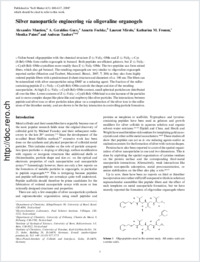Silver nanoparticle engineering via oligovaline organogels
- Mantion, Alexandre Department of Chemistry, University of Basel, Switzerland
- Guex, Anne Géraldine Department of Chemistry, University of Basel, Switzerland
- Foelske, Annette Electrochemistry Laboratory, Paul Scherrer Institute, Villingen, Switzerland
- Mirolo, Laurent Department of Chemistry, University of Fribourg, Switzerland
- Fromm, Katharina M. Department of Chemistry, University of Fribourg, Switzerland
- Painsi, Monika Institute of Geological Sciences, University of Bern, Switzerland
- Taubert, Andreas Department of Chemistry, University of Basel, Switzerland - Institute of Chemistry, University of Potsdam, Golm, Germany
-
24.01.2008
Published in:
- Soft Matter. - 2008, vol. 4, no. 3, p. 606-617
English
L-Valine-based oligopeptides with the chemical structure Z–(L-Val)₃–OMe and Z–(L-Val)₂–L-Cys(S-Bzl)–OMe form stable organogels in butanol. Both peptides are efficient gelators, but Z–(L-Val)₂–L-Cys(S-Bzl)–OMe crystallizes more readily than Z–(L-Val)₃–OMe. The two peptides can form mixed fibers, which also gel butanol. The resulting organogels are very similar to oligovaline organogels reported earlier (Mantion and Taubert, Macromol. Biosci., 2007, 7, 208) as they also form highly ordered peptide fibers with a predominant β-sheet structure and diameters of ca. 100 nm. The fibers can be mineralized with silver nanoparticles using DMF as a reducing agent. The fraction of the sulfur-containing peptide Z–(L-Val)₂–L-Cys(S-Bzl)–OMe controls the shape and size of the resulting nanoparticles. At high Z–(L-Val)₂–L-Cys(S-Bzl)–OMe content, small spherical particles are distributed all over the fiber. Lower contents of Z–(L-Val)₂–L-Cys(S-Bzl)–OMe lead to a size increase of the particles and to more complex shapes like plate-like and raspberry-like silver particles. The interactions between peptide and silver ions or silver particles takes place via a complexation of the silver ions to the sulfur atom of the thioether moiety, and are shown to be the key interaction in controlling particle formation.
- Faculty
- Faculté des sciences et de médecine
- Department
- Département de Chimie
- Language
-
- English
- Classification
- Chemistry
- License
- License undefined
- Identifiers
-
- RERO DOC 9071
- DOI 10.1039/b712826f
- Persistent URL
- https://folia.unifr.ch/unifr/documents/300698
Statistics
Document views: 110
File downloads:
- fromm_snp.pdf: 184
